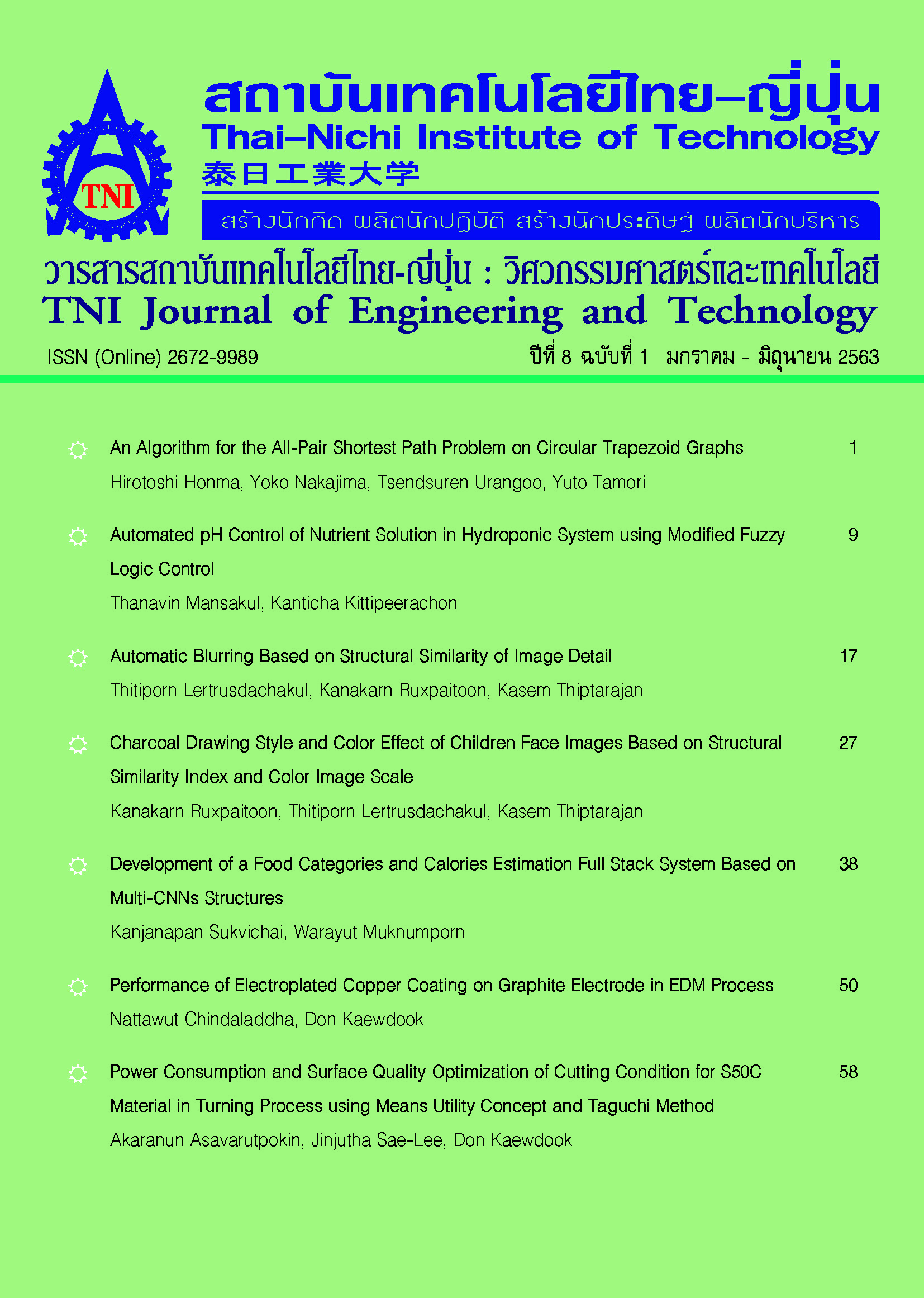Power Consumption and Surface Quality Optimization of Cutting Condition for S50C Material in Turning Process using Means Utility Concept and Taguchi Method
Main Article Content
Abstract
This paper aims to study the effects of cutting condition to the power consumption and surface quality in tuning process on mild steel S50C. The machine was used in this study is CNC turning and carbide cutting tool. The optimize process parameters by means utility concept and Taguchi technique applied to identify the machinability and energy efficiency. The three types of process parameters with five different levels including, cutting speed, feed rate, and depth of cut have been used in this work. The selection of these parameters was based on literature review, and tool manufacturing recommendations. The Taguchi orthogonal array L25(53) have been used for conducting the experiments. The results shown that most significant factor for power consumption is depth of cut (60.58%) followed by feed rate (30.27%) and cutting speed (4.36%). For surface roughness, the most significant factor is feed rate (98.49%) followed by depth of cut (0.99%), and cutting speed (0.02%). Nevertheless, the minimum power consumption of machine condition is in contrast to the surface roughness quality. Therefore, this technique can be applied for production planning to control the product quality and machining cost.
Article Details
Article Accepting Policy
The editorial board of Thai-Nichi Institute of Technology is pleased to receive articles from lecturers and experts in the fields of engineering and technology written in Thai or English. The academic work submitted for publication must not be published in any other publication before and must not be under consideration of other journal submissions. Therefore, those interested in participating in the dissemination of work and knowledge can submit their article to the editorial board for further submission to the screening committee to consider publishing in the journal. The articles that can be published include solely research articles. Interested persons can prepare their articles by reviewing recommendations for article authors.
Copyright infringement is solely the responsibility of the author(s) of the article. Articles that have been published must be screened and reviewed for quality from qualified experts approved by the editorial board.
The text that appears within each article published in this research journal is a personal opinion of each author, nothing related to Thai-Nichi Institute of Technology, and other faculty members in the institution in any way. Responsibilities and accuracy for the content of each article are owned by each author. If there is any mistake, each author will be responsible for his/her own article(s).
The editorial board reserves the right not to bring any content, views or comments of articles in the Journal of Thai-Nichi Institute of Technology to publish before receiving permission from the authorized author(s) in writing. The published work is the copyright of the Journal of Thai-Nichi Institute of Technology.
References
A. Hassan and E. H. Gawad, “Cutting cylindrical Surfaces,” in Fundamentals of Machining Processes-Conventional and Nonconventional Processes, 2nd ed. New York, NY, USA: CRC Press Taylor & Francis Group, 2014, ch. 5, pp. 112-158.
G. Y. Zhao, Y. B. Guo, Z. Y. Liu, Y. He, and H. J. Cao, “Energy Consumption in Machining: Classification, Prediction, and Reduction Strategy,” Energy, vol. 133, pp. 142-157, Aug. 2017.
R. C. V. Nostrand, “Design of Experiments Using the Taguchi Approach: 16 Steps to Product and Process Improvement,” Technometrics, vol. 44, no. 3, pp. 289–289, Aug. 2002.
A. Aggarwal, H. Singh, P. Kumar, and M. Singh, “Optimizing power consumption for CNC turned parts using response surface methodology and Taguchi’s technique—A comparative analysis,” Journal of Materials Processing Technology, vol. 200, no. 1, pp. 373–384, May 2008.
C. C. Negrete, “Optimization of cutting parameters for minimizing energy consumption in turning of AISI 6061 T6 using Taguchi methodology and ANOVA,” Journal of Cleaner Production, vol. 53, pp. 195-203, Aug. 2013.
S. A. Bagaber and A. R. Yusoff, “Multi-objective optimization of cutting parameters to minimize power consumption in dry turning of stainless steel 316,” Journal of Cleaner Production, vol. 157, pp. 30-46, Jul. 2017.
N. Jagannatha, S. S. Hiremath, and K. Sadashivappa, “Analysis and Parametric Optimization of Abrasive Hot Air Jet Machining for Glass using Taguchi Method and Utility Concept,” International Journal of Mechanical and Materials Engineering (IJMME), vol. 7, no. 1, pp. 9-15, 2012.
Sandvik, “CNMG 12 04 08-QM 4325,” SANDVIK.COROMANT.com https://www.sandvik.coromant.com/enb/products/pages/productdetails.aspx?c=CNMG+12+04+08-M+4325 (accessed Feb. 18, 2020).


